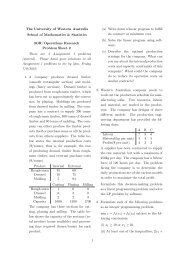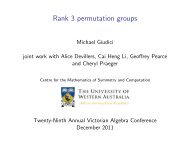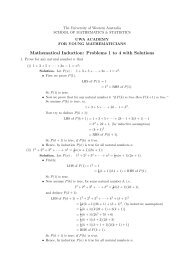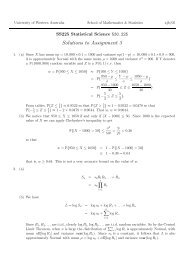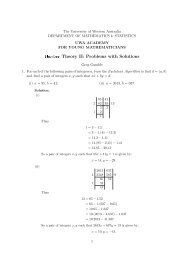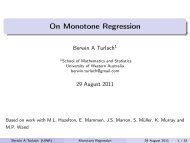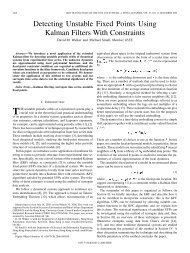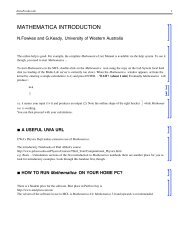Ceva's Theorem Problems with Solutions - The University of ...
Ceva's Theorem Problems with Solutions - The University of ...
Ceva's Theorem Problems with Solutions - The University of ...
- No tags were found...
Create successful ePaper yourself
Turn your PDF publications into a flip-book with our unique Google optimized e-Paper software.
<strong>The</strong> <strong>University</strong> <strong>of</strong> Western Australia<br />
SCHOOL OF MATHEMATICS & STATISTICS<br />
UWA ACADEMY<br />
FOR YOUNG MATHEMATICIANS<br />
Plane Geometry : Ceva’s <strong><strong>The</strong>orem</strong> <strong>Problems</strong><br />
<strong>with</strong> <strong>Solutions</strong><br />
<strong>Problems</strong>.<br />
1. For △ABC, let p and q be the radii <strong>of</strong> two circles through A, touching BC at B and C,<br />
respectively. Prove pq = R 2 .<br />
Solution. Let P be the centre <strong>of</strong> the circle <strong>of</strong> radius p<br />
through A, touching BC at B, and let Q be the centre<br />
<strong>of</strong> the circle <strong>of</strong> radius q through A, touching BC at C.<br />
Produce CQ to meet the circle centred at Q again at Y ,<br />
so that CY is a diameter. <strong>The</strong>n<br />
∠C = ∠ACB = ∠AYB, by <strong><strong>The</strong>orem</strong> 29<br />
∠CAY = 90 ◦ , by <strong><strong>The</strong>orem</strong> 20<br />
P<br />
p<br />
B<br />
c<br />
A<br />
b<br />
Y<br />
Q<br />
q<br />
C<br />
Multiplying, (2) and (1) we have<br />
∴ sin C = sin(∠AYB) = b<br />
2q<br />
∴ 2q =<br />
b<br />
sin C<br />
Similarly, 2p =<br />
c<br />
sin B<br />
(1)<br />
(2)<br />
∴ 2p · 2q =<br />
b<br />
sin C · c<br />
sin B<br />
= b<br />
sin B · c<br />
sin C<br />
= 2R · 2R, by the Sine Rule<br />
∴ pq = R 2 .<br />
2. If X, Y , Z are the midpoints <strong>of</strong> sides BC, CA, AB, respectively, <strong>of</strong> △ABC, prove the<br />
cevians AX, BY , CZ are concurrent.<br />
<strong>The</strong> cevians AX, BY , CZ here, are the medians <strong>of</strong> △ABC and the point at which they<br />
concur is the centroid or centre <strong>of</strong> gravity <strong>of</strong> △ABC.<br />
Solution. If the cevians are medians we have:<br />
A<br />
BX = XC, CY = Y A, AZ = ZB<br />
∴ BX<br />
XC<br />
CY<br />
Y A<br />
AZ<br />
ZB = 1.<br />
Z<br />
Y<br />
Hence by Ceva’s <strong><strong>The</strong>orem</strong>, AX, BY , CZ concur. <strong>The</strong> point<br />
<strong>of</strong> concurrence is <strong>of</strong>ten labelled G (memonical for centre <strong>of</strong><br />
Gravity).<br />
B<br />
X<br />
C
3. Prove cevians perpendicular to the opposite sides are concurrent.<br />
Such cevians <strong>of</strong> a triangle are its altitudes and the point at which they concur is the<br />
orthocentre.<br />
Solution. Suppose cevians AX, BY , CZ are altitudes <strong>of</strong> △ABC. <strong>The</strong>n<br />
∠AXC = ∠BY C = 90 ◦<br />
∠XCA = ∠Y CB,<br />
(same angle)<br />
∴ △AXC ∼ △BY C, by the AA Rule (3)<br />
Similarly,<br />
△CZA ∼ △BY A (4)<br />
and △AXB ∼ △CZB (5)<br />
∴ CY<br />
XC = Y C<br />
XC = BY , by (3)<br />
AX<br />
AZ<br />
Y A = ZA<br />
Y A = CZ , by (4)<br />
BY<br />
BX<br />
ZB = XB<br />
ZB = AX , by (5)<br />
CZ<br />
∴ BX CY AZ<br />
XC Y A ZB = CY AZ BX<br />
XC Y A ZB<br />
= BY CZ AX<br />
AX BY CZ<br />
= 1<br />
B<br />
Z<br />
A<br />
X<br />
Y<br />
C<br />
Hence by Ceva’s <strong><strong>The</strong>orem</strong>, AX, BY , CZ concur. <strong>The</strong> point <strong>of</strong> concurrence is <strong>of</strong>ten labelled<br />
H (perhaps memonical for ortH ocentre).<br />
A<br />
4. Let AX be a cevian <strong>of</strong> △ABC <strong>of</strong> length p dividing BC<br />
into segments BX = m and XC = n. Prove<br />
a(p 2 + mn) = b 2 m + c 2 n.<br />
This result is known as Stewart’s <strong><strong>The</strong>orem</strong>.<br />
Hint. Use the Cosine Rule on each <strong>of</strong> △ABX and B m X n C<br />
△AXC, in each case taking the cosine <strong>of</strong> the angle at X. What relationship do the cosines<br />
<strong>of</strong> supplementary angles have<br />
Solution. Applying the Cosine Rule to △ABX and △AXC, we have<br />
c 2 = p 2 + m 2 − 2pm cos(∠AXB) (6)<br />
b 2 = p 2 + n 2 − 2pn cos(∠AXC) (7)<br />
Now ∠AXB and ∠AXC are supplementary; so their cosines are the negatives <strong>of</strong> one<br />
another. So we multiply each <strong>of</strong> (6) and (7) by appropriate constants so that the cosine<br />
expressions will cancel when the resulting equations are added:<br />
n × (6) : nc 2 = np 2 + nm 2 − 2pmn cos(∠AXB) (8)<br />
m × (7) : mb 2 = mp 2 + mn 2 − 2pmn cos(∠AXC) (9)<br />
∴ nc 2 + mb 2 = (n + m)p 2 + (n + m)mn, (8) + (9)<br />
∴ nc 2 + mb 2 = ap 2 + amn,<br />
∴ a(p 2 + mn) = b 2 m + c 2 n<br />
c<br />
p<br />
since m + n = BC = a<br />
b<br />
2
5. Prove that the medians <strong>of</strong> a triangle dissect the triangle into six smaller triangles <strong>of</strong> equal<br />
area.<br />
Solution. Suppose △ABC has medians AX, BY, CZ as per the diagram.<br />
First, since AX is a median,<br />
A<br />
BX = XC.<br />
Regarding these as the bases <strong>of</strong> △GBX and △GXC, respectively,<br />
which then have a common altitude to G from BC, it<br />
follows that the areas <strong>of</strong> these triangles are equal, i.e.<br />
Z<br />
G<br />
Y<br />
(GBX) = (GXC) = x say.<br />
Similarly, since BY is a median, CY = Y A which are bases for △GCY and △GY A that<br />
have a common altitude to G from CA, so that<br />
(GCY ) = (GY A) = y say,<br />
and since CZ is a median, AX = ZB which are bases for △GAZ and △GZB that have<br />
a common altitude to G from AB, so that<br />
(GAZ) = (GZB) = z say.<br />
A<br />
Updating our diagram <strong>with</strong> x, y, z we have the diagram, at right.<br />
Since, △ABX and △AXC have equal bases BX and XC,<br />
<strong>with</strong> a common altitude to A from BC. So,<br />
2z + x = (ABX) = (AXC) = 2y + x<br />
∴ 2z = 2y<br />
z = y<br />
Similarly, △CAZ and △CZB have equal bases AZ and ZB, <strong>with</strong> a common altitude to<br />
C from AB. So,<br />
2y + z = (CAZ) = (CZB) = 2x + z<br />
∴ 2y = 2x<br />
y = x<br />
∴ x = y = z.<br />
Thus the six smaller triangles all have equal area, and so the medians <strong>of</strong> a triangle dissect<br />
△ABC into six smaller triangles <strong>of</strong> equal area.<br />
6. Prove the medians <strong>of</strong> a triangle divide each other in the ratio 2 : 1, i.e. the medians <strong>of</strong> a<br />
triangle trisect one another.<br />
Solution. From the previous problem we have that the medians <strong>of</strong> a triangle dissect the<br />
triangle into six triangles <strong>of</strong> a common area x, say.<br />
A<br />
Now, △CAG and △CGX can be taken to have bases AG and<br />
GX, respectively, <strong>with</strong> common altitude to C from AX. So<br />
the ratio <strong>of</strong> their bases is equal to the ratio <strong>of</strong> their areas, i.e.<br />
Z<br />
x x<br />
Y<br />
Similarly,<br />
AG : GX = (CAG) : (CGX)<br />
= 2x : x<br />
= 2 : 1.<br />
Hence the medians trisect one another.<br />
BG : GY = CG : GZ = 2 : 1.<br />
3<br />
B<br />
B<br />
B<br />
Z<br />
z<br />
x<br />
z<br />
G<br />
x<br />
G<br />
x<br />
X<br />
y<br />
X<br />
X<br />
x<br />
Y<br />
y<br />
x<br />
x<br />
C<br />
C<br />
C
7. Prove that each (internal) angle bisector <strong>of</strong> a triangle<br />
divides the opposite side into segments proportional in<br />
length to the adjacent sides, e.g. if AX is the cevian<br />
<strong>of</strong> △ABC that bisects the angle at A internally, then<br />
BX : XC = c : b.<br />
Hint. Use the Sine Rule on each <strong>of</strong> △ABX and △AXC,<br />
in each case taking the sine <strong>of</strong> the angle at X.<br />
B<br />
What relationship do the sines <strong>of</strong> supplementary angles have<br />
c<br />
A<br />
α α<br />
X<br />
b<br />
C<br />
Solution. Let us abbreviate the size <strong>of</strong> ∠AXB and ∠AXC by X • and X ◦ , respectively.<br />
<strong>The</strong>n, since X • and X ◦ are supplementary, i.e. X • + X ◦ = 180 ◦ , we have<br />
Applying, the Sine Rule in △AXB, we have<br />
Similarly, in △AXC we have<br />
So, we have<br />
i.e. BX : XC = c : b.<br />
sin X • = sin X ◦ .<br />
BX<br />
sin α =<br />
XC<br />
sin α =<br />
c<br />
sin X •<br />
.<br />
b<br />
sin X ◦<br />
.<br />
BX<br />
XC = BX /sin α<br />
XC/sin α = c /sin X •<br />
b/sin X ◦<br />
= c b ,<br />
8. <strong>The</strong> angle bisector <strong>of</strong> the angle between two sides is the locus <strong>of</strong> points that are equidistant<br />
from the sides making the angle. One consequence <strong>of</strong> this is that any pair <strong>of</strong> internal angle<br />
bisectors <strong>of</strong> a triangle meet at a point that is equidistant from all three sides <strong>of</strong> the triangle,<br />
and hence in fact the three internal angle bisectors are concurrent.<br />
<strong>The</strong> point at which the angle bisectors <strong>of</strong> a triangle concur is the incentre I, the common<br />
(perpendicular) distance from I to the three sides is the inradius r, and the circle <strong>with</strong><br />
centre I and radius r thus touches each side tangentially and is called the incircle <strong>of</strong> the<br />
triangle.<br />
Find an alternative pro<strong>of</strong> that the (internal) angle bisectors <strong>of</strong> a triangle concur, using<br />
Ceva’s <strong><strong>The</strong>orem</strong> and the result <strong>of</strong> the previous problem.<br />
Solution. Let AX, BY, CZ be angle bisectors <strong>of</strong> △ABC. From the previous problem,<br />
since AX is an angle bisector<br />
BX<br />
XC = c b .<br />
Likewise, since BY is an angle bisector,<br />
and, since CZ is an angle bisector,<br />
Hence,<br />
BX<br />
XC<br />
CY<br />
Y A = a c ,<br />
AZ<br />
ZB = b a .<br />
CY<br />
Y A<br />
AZ<br />
ZB = c a<br />
b c<br />
= 1,<br />
and so by Ceva’s <strong><strong>The</strong>orem</strong>, cevians AX, BY, CZ are concurrent.<br />
b<br />
a<br />
4



